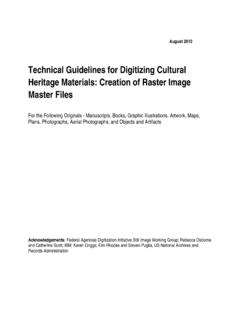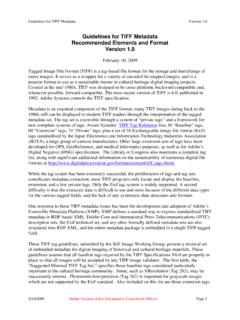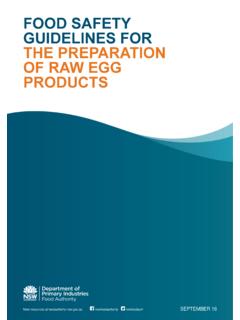Transcription of Federal Agencies Digitization Guidelines Initiative ...
1 Digitization Activities November 4, 2009 Federal Agencies Digitization Guidelines Initiative 1 Federal Agencies Digitization Guidelines Initiative Digitization ACTIVITIES Project Planning and Management Outline Version November 2009 Digitization Activities November 4, 2009 Federal Agencies Digitization Guidelines Initiative 2 Document Information and Version History Title Digitization Activities Author Federal Agencies Digitization Guidelines Initiative Still Image Working Group Document Type Technical Guideline Publication Date 2009 Date of Revision Author(s) September 2009 FADGI v1 August 2008 National Archives and Records Administration ( ) internal draft by Steven Puglia, Erin Rhodes, and Kevin DeVorsey Digitization Activities November 4, 2009 Federal Agencies Digitization Guidelines Initiative 3 Table of Contents o Introduction - 4 Defines the purpose of this document by outlining high-level activities related to the Digitization of cultural heritage materials for planning and management purposes.
2 We have defined a generic sequence of activities and workflow for Digitization . We relate these activities to library/archival issues, imaging and conversion work, and IT infrastructure in particular. We discuss guidance and related frameworks, including record keeping principles and sustainability factors that should be considered. o Assumptions - 7 Provides general assumptions regarding Digitization , including aspects that may differ depending on the rationale for digitizing, as well as on the nature of the originals. As there is no single approach to Digitization , specific work processes should be tailored to each individual Digitization effort.
3 O General Policy Issues - 8 Lists policy-related issues to be addressed from an institutional perspective, including: policies and procedures relating to Digitization , recommendations for sustainable data formats, creation and management of metadata schema, definition of essential characteristics, appropriate information capture and quality levels for Digitization , verifying authenticity of digital copies, and ensuring appropriate records management of digital resources, if applicable. o Approaches to Digitization Chart - 9 Illustrates a complement of different approaches to and purposes for Digitization , including: improving access to collections, preservation reformatting, Digitization for exhibits and reference requests, conservation documentation, classified records review, and Digitization of current business records.
4 O Digitization Technical Requirements - 10 Lists components that form the basis of Digitization specifications. Technical requirements should address: digital conversion parameters for original materials, recommended data formats and digital object types, assignment of copy or record status, identification of work processes, responsibilities, roles, resources, metadata, identifiers, quality management, etc. o Digitization Activities - 11 Describes the nature and sequence of high-level activities necessary to plan, conduct and manage Digitization projects, including: selection, assessment, and prioritization; project planning, management, and tracking; copy status and records management; preparation of originals for Digitization ; metadata creation and management; Digitization ; data collection and management; and assessment and evaluation.
5 O Digitization Activities Chart - 14 Provides a visual overview of the relationships and sequencing of Digitization activities. o Detailed Outline - 15 Provides an in-depth outline illustrating the management, operational, and assessment activities within each of the four phases of Digitization workflow. o Infrastructure Issues - 22 Provides a brief outline of IT infrastructure needs to support and facilitate Digitization projects. o Resources - 23 List of resources consulted for this document. Digitization Activities November 4, 2009 Federal Agencies Digitization Guidelines Initiative 4 Introduction This document attempts to define work activities relating to the Digitization of original cultural materials.
6 The intention is to outline a generic sequence of high-level activities for planning and management purposes. In this document, we present a conceptual outline that accommodates most Digitization approaches, but one that acknowledges all steps may or may not apply, may occur in different sequences, or may occur simultaneously depending on the type of project and the context of the Digitization . The activities described and the general sequencing of the work processes were identified using project management outlines from a number of organizations that had significant experience with the Digitization of cultural materials.
7 In this document, we define digitizing as the creation of digital objects from physical originals. So-called born digital objects (both born-digital content and current business records) are not in scope in this document at this time, although many of the activities outlined in this document will likely apply to born digital materials as well. We define Digitization as a complete process that broadly includes: selection, assessment, prioritization, project management and tracking, preparation of originals for Digitization , metadata collection and creation, digitizing, quality management, data collection and management, submission of digital resources to delivery systems and into a repository environment, and assessment and evaluation of the Digitization effort.
8 This document divides the processes involved in a Digitization workflow into four main phases: Project planning Processes occurring prior to Digitization Digital conversion Post- Digitization work Project planning and management, data collection, and quality management are considered to be some of the ongoing activities throughout all four phases of the Digitization workflow. The activities described within each phase address library/archival issues, imaging and conversion work, and IT infrastructure issues. Library and archival issues include preparation of originals for Digitization , indexing, collection and creation of metadata of all types, and quality control of the digital versions, indexing data, and other metadata.
9 Imaging/conversion work includes Digitization , creation of derivative versions for access, quality control, and metadata creation. IT infrastructure issues include: collection and transfer of data to other systems, networked and Web services, databases, and managed storage and backup. Additional IT infrastructure issues include: short-term/intermediate data storage, backup of digital resources for disaster recover, and safeguards and checks to protect against data loss and to ensure data integrity. The Archives New Zealand S-6 Digitisation Standard provides a similar framework for Digitization projects as this document, and lists a set of mandatory requirements for Digitization processes.
10 A partial list of those requirements, appropriate for cultural heritage institutions, is listed below some of the requirements have been reworded to be more generic. We have listed them here as they dovetail nicely with concepts outlined in the four phases of Digitization workflow as described earlier. For a more detailed discussion of the Archives New Zealand requirements, go to All Digitization and Digitization processes must be planned, scoped and documented An appropriate Digitization approach must be selected, documented and implemented Technical specifications aligned to the Digitization requirements must be selected.







